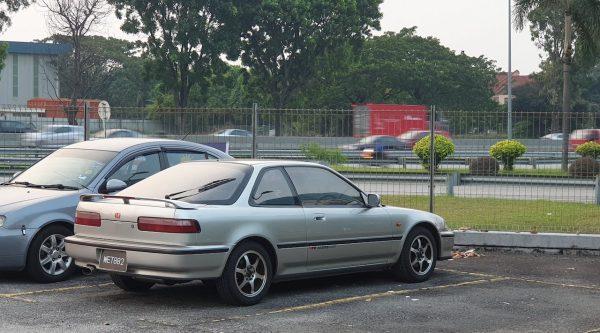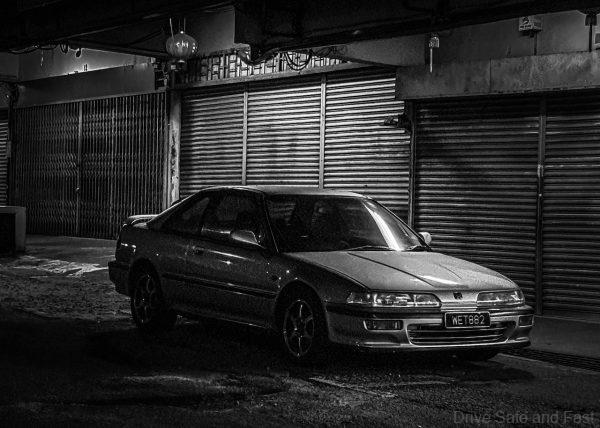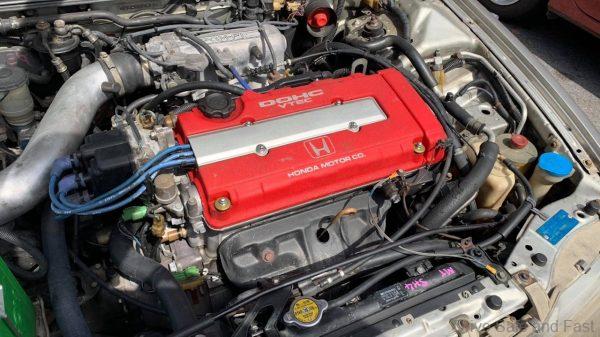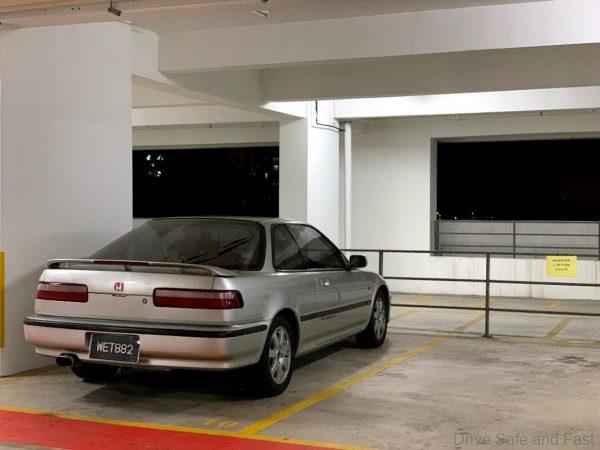Our review of the 2nd generation Honda Integra XSi or DA6 Hatchback.
Introduction
The 1991 Honda Integra is not a straightforward vehicle to describe. It was the first vehicle to be called the “Honda Integra”, but at the same time, also considered the second-generation Honda Integra, as the model it replaced was called the Honda Quint Integra. Even its bodystyle is a little misleading. At first glance, it looks like a coupé, but it is in fact a 3-door hatchback “hardtop” (frameless windows). There’s also a four-door sedan “hardtop” with frameless windows as well, and these are generally a little more affordable than the 3-door bodies. This generation of Integra is also still a little bit neglected amongst Honda enthusiasts and collectors. That’s because its engine isn’t one of the higher-output VTECs like the B18C, and it suffers from an ever-dwindling supply of spare parts, unlike the K20 VTEC engines.

More ‘collectable’ Hondas from the late-80s/early-90s like the 2nd-generation CR-X and 3-door Civics tend to command higher prices and we suspect this is down to the recognisable hatchback shapes of these vehicles. The 2nd generation Integra is overshadowed not only by its more successful successors, but by these traditional 3-door contemporaries.

So, it’s not the first Integra, it’s not the fastest Integra, it’s not a coupé, it’s not even particularly easy to get parts for.

Thankfully, that’s about all there is to dissuade potential ownership of this particular model. Everything else about the car is actually positive. I owned one of these 1991 Honda Integras with a manual gearbox from mid-2019 and Q3-2021 and here’s my experience of the car.

Performance
One trump card that this Integra can boast is that it’s the first Honda to ever feature a VTEC engine. Honda introduced the B16A engine with this vehicle and began a legacy that remains to this day. The B16A engine put out between 160hp-170hp with between 150-170Nm of torque all while delivering the expected fuel-sipping qualities of a 1.6L four pot Honda engine.
From my use, it was not uncommon to get 450km out of its 50L fuel tank. While not particularly exceptional, it’s actually really cheap considering this was a 30-year-old “sportscar”.
Is it a sportscar?
The Honda Integra’s driving performance is characterised by these aspects
- close gear ratios
- effortless acceleration
- firm suspension and good steering feedback

The Integra is at home on tighter B-roads and the car feels a lot faster than it is. The revs climb quickly even before engaging VTEC and you’ll rarely find yourself not rowing between gears. If you’re a three pedal enthusiast, the Integra is quite a great buy. The clutch is actually not heavy at all, feeling almost exactly the same as the era-equivalent Civic SH4’s clutch weight and gear shifts are satisfying and sure, but not as notchy as one might expect.

The car feels like it was tuned to be a sportscar, for sure. However, it also lacks any real speed thanks to the close ratios of the gearbox, mostly. Getting from 0-100km/h doesn’t take any effort, but its acceleration starts to drop off a little after that. It’s a sportscar for short bursts of rapid acceleration and quick thrills. But I suspect its stablemate, the CR-X, would fare better on a track thanks to its shorter wheelbase.

I have driven the Integra to and from Johor Bahru. I wouldn’t recommend it. At 110km/h, the engine’s revving at over 3,000 rpm in 5th gear at best and every road surface imperfection is transmitted to your spine. It’s a sensory overload and the opposite of what a nice relaxing highway journey should be like.
Design
In terms of design, this Honda Integra doesn’t have the iconic look of its predecessors. However, you can clearly see the lineage between the DA6 and the JDM DC2. There is also a distinct lack in sporty aggression on this vehicle. Besides the low ride height and sleek silhouette, the only real tell that it’s supposed to be a fast car is the spoiler. The body kit and the lines in general are quite soft and almost Civic-like. There are Mugen aftermarket kits that remedy this, but those kits are hard to come across.

Some of the standout design features on the DA6 Integra are the rounded rear glass on the hatchback door, the frameless windows and the slit headlights that take up most of the car’s face. The headlights house the main beams, high beams, position lights as well as the foglights with the turn signals being housed in the bumper. The front grille intake is also positioned on the bumper, giving the car a very aerodynamic look.

From the side, the Integra DA6 projects a coupé look thanks to its low angled rear glass. However, this is just an illusion and the result is an exceptionally long tailgate that’s lifted by two gas struts. Replacements for these parts are easy to find. I got mine on Lazada from a supplier in China for under RM50 and they bolted on without fuss.

The boot is fairly large with room for space saver spare tyre underneath. There’s also a little lamp for illumination of the trunk at night which can be manually turned on and off. The rear seats can be folded down in a 50:50 split with pull pins. The tonneau cover can be folded in half and then released from its housing and stored in the car or at home. With the tonneau cover out of the way and the rear seats folded down, the Integra DA6 has a surprisingly large amount of luggage space available. Just pay attention to the high opening of the boot, which won’t let you slide things in. You also need to be aware of the height of the items your loading as they may smash right through the rear glass when the hatch is shut. There aren’t any hooks or nets or clever storage solutions beyond the folding seats.

Inside, the Integra DA6 was widely available with fabric seats and upholstery. It’s actually a very pleasant interior with no frills and elegant design. Plastic bits are generally not too shabby but expect some scratches on the door handles. The top half of the interior and dashboard is wrapped in vinyl and this tends to hold up ok if the car isn’t parked in direct sunlight. Two major steering wheel designs exist
Value
The 1991 Honda Integra 3-Door was hovering between RM14,000-RM20,000 in mid 2019 before the pandemic, classic JDM madness and the chip shortage. Today, prices have shot up and you’ll be hard-pressed to find anything below RM20,000. Be aware of buying units that need a lot of work. The B16A block and head are durable, and many wear and tear parts are still available. However, certain parts are getting extremely tough to find. The mechanic in charge of my unit had to fabricate a bushing and rebuild the distributor as these parts proved impossible to find in Malaysia in good condition. He also had to source a radiator from a half-cut. Ensure you have a trusted mechanic with experience in older Japanese cars who can help spot signs of trouble, but in most cases most of these issues are relatively cheap to fix – gaskets, hoses and fuses/relays.

Trim pieces and interior parts are also a little tough to come by. My unit had a melted top glove box, a broken coin box, AC control flap, and aircond vent. If you have the patience to mend these yourself, you could get away with a presentable looking vehicle. However, original parts will surface from time to time at ridiculous prices. The top glove box, for instance, would have set me back RM700. And from the looks of it, the material on this part would have degraded in our climate given enough time anyway.

Overall, it’s one of the most low-maintenance, low entry cost JDM sportscars on the market. Sure, it’s also not that fast and not that desirable, but if you’re looking for a fun weekend toy that won’t break the bank, it’s actually quite a great deal.
Honda Integra XSi Specifications
Engine: Inline-4, 16-Valve, DOHC VTEC
Capacity: 1595cc
Gearbox: 5-speed manual
Max power: 160hp @ 7600rpm
Max torque: 150Nm @ 7000rpm
0-100 km/h: 7.2 seconds